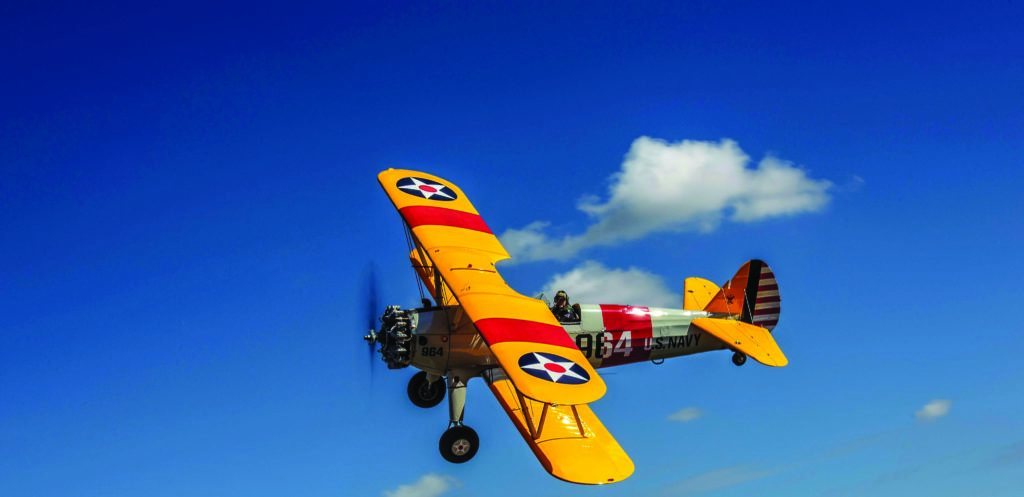Not All Vintage Vehicles Are Cars or Trucks
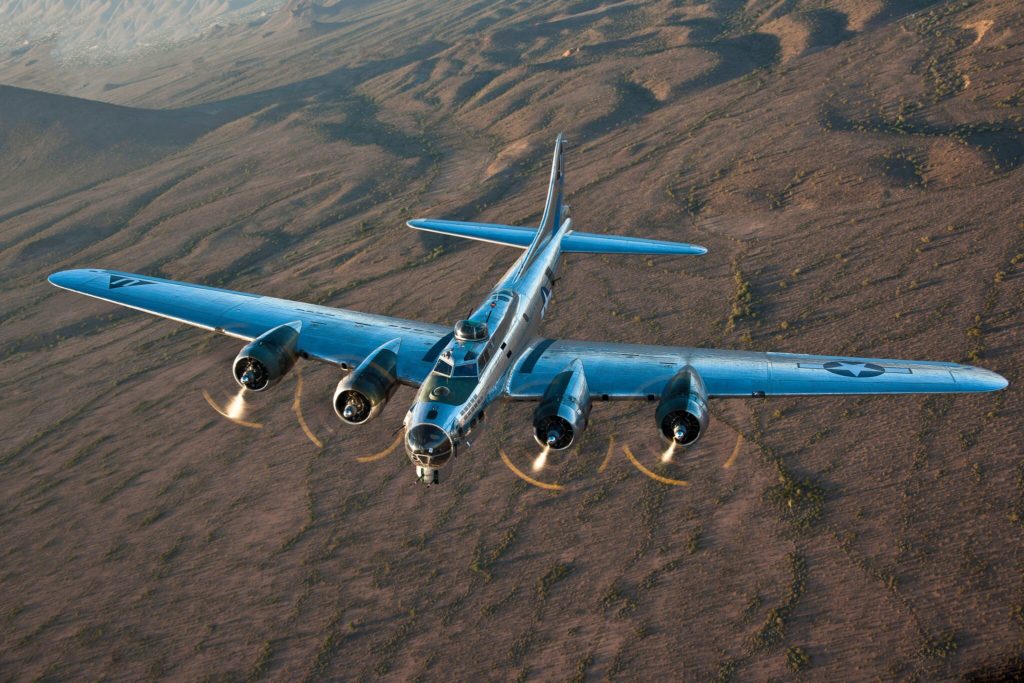
Keeping a WWII Warplane Operational Requires Work and Constant Maintenance. Sounds Familiar, Doesn’t It?
By Bo Shaw (as it appeared in the Auto Restorer Magazine, January 2018 issue)
Editor’s note: AR contributor Bo Shaw generally writes about his restored TR3A or his current Triumph Spitfire restoration project. But when we learned that he’s also involved with an organization that restores, maintains and flies vintage WWII aircraft, we asked him to tell us more about the group, its warbirds and a typical day on tour. As it turns out, vintage aircraft and cars tend to have a lot in common.
It was like Christmas in June when I first discovered that, purely by chance, our family move to Mesa, Arizona, had placed us within three miles of the Arizona Wing (now known as Airbase Arizona) of the Commemorative Air Force (CAF).
Airbase Arizona (AZCAF), a volunteer organization of some 400+ members, is one of the largest units of the CAF, and is a treasure trove of WWII and vintage aircraft that includes both a Boeing B-17G Flying Fortress and a North American B-25J Mitchell bomber, each of which earned fame fighting in the world’s skies during World War II. (The B-17 fought in many a pitched air battle over Germany, and the B-25 was famous for being the bomber launched from the Navy carrier Hornet for the Doolittle Raid against Tokyo in April, 1942.)
I cannot remember which attracted me first as a kid…airplanes, particularly of the WWII variety, or Little British Cars (LBCs). But it doesn’t make any difference for both have been equally subject to a life-long fascination. In any case, I took the first steps to becoming a member of the AZCAF that same June day.
Getting Involved
Airbase Arizona is a complex organization with many varied volunteer positions, but I especially gravitated to the flying aspect of the museum. AZCAF is a “flying museum” with many of the 25+ aircraft based there maintained in flying condition, and, of these, seven from the WWII era are used to provide the public with an opportunity to fly aboard these historic aircraft to relive the experiences of the young men who flew them to war. Two of the aircraft used for these flights
are the aforesaid B-17G and the B-25J, and my goal was to become a flight crew member for both aircraft.
AZCAF conducts ground training each winter for those who are interested in becoming fight crew members. The flying positions for the B-17/B-25 are: pilot, copilot, flight crew chief (FCC) and flight loadmaster (FLM)/observer. The pilots are usually commercial or ex-military with thousands of flight hours and who receive additional specialized training in the peculiarities of the AZCAF aircraft they fly. The flight crew chiefs are responsible for the general maintenance of the aircraft. The flight loadmaster (FLM)/observer is the entry position for AZCAF non-pilot crewmembers, and I have been an FLM on both the B-17 and the B-25 since completion of my ground training three years ago. The duties of the FLM are diverse, and, in concert with the other crew members and ground personnel, essential to the safe operation of the aircraft. Many loadmasters eventually advance to the flight crew chief position, which entails additional training and a detailed knowledge of the aircraft for which they are rated.
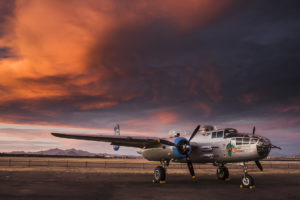
Attracted to the Maid
Although I am qualified as a loadmaster on both the B-17 and the B-25, the AZCAF B-25J, “Maid in the Shade”, is my favorite aircraft of the two. This aircraft is one of the few true WWII combat veterans still flying, having flown fifteen missions in the Mediterranean theatre in late 1944, and she bears the battle scars to prove it.
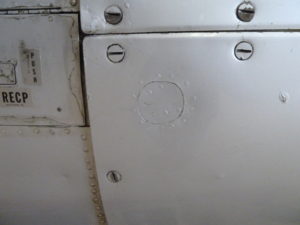
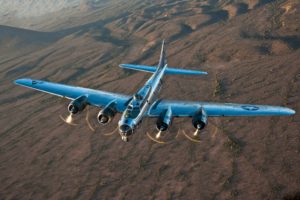
The “Maid” served in the USAF after the war until the late 1950’s, when she was retired to civilian duties as an aerial sprayer. By the time AZCAF acquired her in 1981, the “Maid” was very worn and the dedicated maintenance personnel of Airbase Arizona worked for twenty-eight years restoring the B-25 to her present near-pristine condition. The AZCAF B-17G, “Sentimental Journey”, is a terrific aircraft, majestic in flight, but the “Maid” is like a sports car (the obvious appeal to me), responsive and fast.
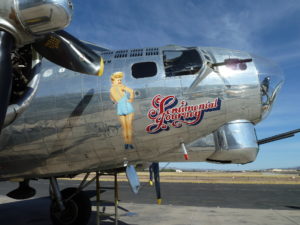 Both “Sentimental Journey” and “Maid in the Shade” earn their keep by providing “historical flight experiences” to the public as noted above. Both aircraft are based at Falcon Field in Mesa, AZ, during the winter months but during the summer (late May-September) they each go on tour throughout the United States and Canada. Flights can be booked on the AZCAF website (azcaf.org).
Both “Sentimental Journey” and “Maid in the Shade” earn their keep by providing “historical flight experiences” to the public as noted above. Both aircraft are based at Falcon Field in Mesa, AZ, during the winter months but during the summer (late May-September) they each go on tour throughout the United States and Canada. Flights can be booked on the AZCAF website (azcaf.org). 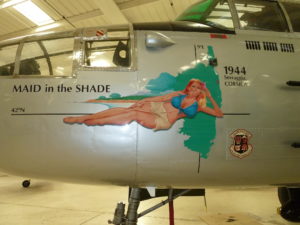
I have now toured with the “Maid” three times through the central and western Canadian provinces (mainly because I have a passport). Here’s what a day on tour with the “Maid” is like.
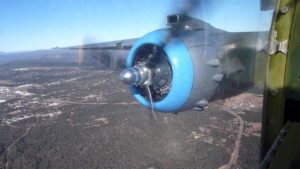
Time for Takeoff
Tour days start early, particularly if there are flights scheduled, and the days generally last ten to twelve hours.
Upon arrival at the airfield, I go through the FLM pre-flight checklist for the aircraft, which mainly consists of ensuring that the safety equipment is in place and operable, flight gear is properly secured and/or stowed, and that the anti-tamper wires on hatches and equipment are still in place. Any discrepancies must be corrected before flight.
Once I’ve completed the FLM pre-flight checklist and if time permits, I assist the flight crew chief with his checklist. The loadmaster isn’t required to do this, but it is good training as I have aspirations of becoming a flight crew chief.
Part of the FCC’s exterior routine is to check the fuel level in each of the “Maid’s” tanks by climbing up on top of the wing (about 12 feet above ground level) and “dipping” each of the four wing fuel tanks, two on each side, with a wooden stake graduated in gallons. (The aircraft fuel gauges are considered unreliable.) The “Maid” has a total fuel capacity of 670 gallons of 100L/L. But as her two Wright Double Cyclone R-2600 radial engines, each with two rows of seven cylinders (fourteen total) combining for 2600 cubic inches of displacement, burn about 75 gallons/hour apiece, the fuel requires frequent replenishment.
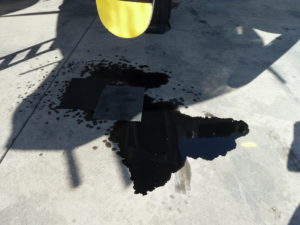
The oil level for each engine is also checked while atop the wing. The Wright R-2600 is essentially a dry sump design, as are all radials, and so the oil is stored in a 37.5-gallon tank mounted on the nacelle firewall behind each engine. The Maid’s engines each use about 1 gallon/hour of oil in flight, but also leak about that same rate while on the ground or seem to. (In that regard, the Maid’s radial engines are like my beloved British sports cars: If they are not leaking oil, they are out of oil.)
These oil “leaks” are also the reason for a radial ritual: “propping” the engine prior to start. If a radial engine has been sitting for twenty minutes or longer, it is necessary to turn it at least two full revolutions with the ignition OFF to assure that no oil has seeped from the crankcase into the bottom cylinders. This leakage could lead to “hydraulic lock”, which can cause severe damage to an engine, e.g., bent rods, broken pistons, cracked cylinder barrels, etc. (Remember from high school physics that a liquid is not compressible?) To avoid this, the engine is turned by “six blades” (the Maid’s R-2600 has a three-bladed propeller) to assure that there is no oil accumulated in the lower cylinders. This procedure is usually performed by the air and ground crew, two people or more for each blade in sequence, muscling the propeller through a full two revolutions before attempting engine start. (Sometimes an enthusiastic passenger will join in. It’s all part of the experience.)
If the prop will not move with reasonable force applied, then it is necessary to remove the bottom engine cowling, guess which of the three lower cylinders is the culprit, and remove at least one of the two spark plugs for the selected cylinder. If we are lucky, about a quart of oil will flow out. If not, the spark plug removal routine is repeated with the other cylinders until oil does flow and then the cowling reassembled.
Prepping the Passengers
Once the pre-flight checklists are complete and the Maid serviced, I retreat to the trailer to complete the passenger paperwork. This includes the passenger manifest, release form and a one-time membership in the AZCAF for the purposes of the flight. Each form must be completed and signed by each passenger prior to flight.
After paperwork completion, I gather together those flying to give the FAA-mandated briefing. I go over the aircraft safety features and procedures, answer questions and generally endeavor to put the riders at ease. The passengers are then guided to the aircraft. The Maid can accommodate up to seven people (not including the flight crew), three passengers in the nose section of the aircraft, and the remaining four enter the waist section of the aircraft, which is the FLM station, by climbing the aft entry hatch.
When operational during the war, the waist section of the B-25 was intended to hold only two men, the waist and tail gunners. Now there are five, including myself. Granted, there are “cushioned” seats for the passengers, but the chromate green interior is cramped and sparse in terms of creature comforts.
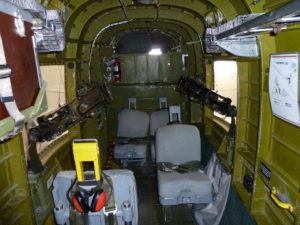
There are, in fact, no creature comforts whatsoever. This airplane was built for combat, not comfort, and the AZCAF has done little to alter that. Once inside, I get the passengers belted into their seats, point out the escape hatches and the red “Do Not Touch” handles, make sure that they have hearing protection, and once again go over the safety procedures while we wait for engine start.
It Gets Loud and Hot in There
The wait helps the passengers to experience another aspect of the war-time flyer. It can get warm inside the B-25 while waiting for engine start and taxi. Let me restate that: The aircraft interior will get uncomfortably hot unless it is early morning or a cool overcast day. The Maid has no insulation and definitely no air conditioning. (Remember: combat, not comfort.) It is a little like sitting in a big tin can, an impression that is definitely reinforced when the engines roar to life. The Wright R-2600s are LOUD. The Maid’s engines are fitted with open exhaust stacks (think of seven or eight V8 engines running simultaneously with open headers), and the radials make their presence known with a veritable wall of sound at startup. That, and a huge cloud of blue smoke as any residual oil in the radial’s cylinders is burned off. (I have already briefed the passengers that, no, the aircraft is not on fire.)
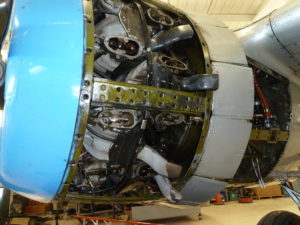
While at idle waiting for the cylinder head temperatures to come up to the operating range, the R-2600s will emit the occasional backfire, adding to the two engine’s already considerable staccato cacophony…with each backfire resounding like a hard-thrown baseball hitting the side of the aircraft. (I have told the passengers to expect this too. All part of the experience.) I use the time after engine start and before taxiing to look for fluid leaks, assess the engine smoke (quite a bit can be determined by the color and pattern of the engine’s smoke), and check for the correct control surface movements as the pilots run through the checklist.
Off We Go…
Taxi finally starts once the engines are up to temperature and the pre-taxi checklists completed. The Maid’s interior begins to cool as the air circulates through the many gaps in her fuselage. Once the end of the runway is reached, there is a pause to run up each Wright engine for the magneto and propeller control checks. Checks complete, the pilots line the Maid up with the runway and we are off. Acceleration is rapid in the Maid, much faster than would normally be expected for a bomber of this vintage (the Maid was built in 1944), but the Wrights are churning out 1700 hp each and the Maid is several tons below her wartime operational weight. In any case, the Maid is in the air with lots of runway remaining and I watch the main landing gear for proper operation as it cycles closed.
After gear-up, I use hand motions to inform the passengers that they can unbuckle and get out of their seats. The requisite hand motions have been briefed to the passengers earlier, and are absolutely necessary as the combination of wind and engine noise make any form of verbal communication impossible. (I am the only one in the waist on intercom.)
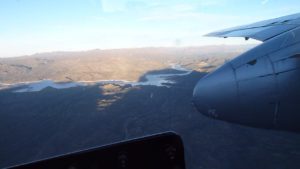
A flight in the Maid lasts about 20 minutes, and the passengers take advantage of this time to marvel at the views available from the two large waist gunner windows, one on each side of the fuselage and to pose for pictures with the .50 caliber Browning M2 machine guns (demilitarized, of course) perched at each waist position.
During the flight I motion each passenger back for their allotted turn in the tail gunner’s position. This involves crawling through a short tunnel but the crawl is rewarded with a spectacular view. Soon I hear the pilots going through the pre-landing checklist over the intercom, and the passengers are motioned back to strap into their seats. I again monitor the landing gear as it comes down, and we are shortly back on the ground where the engines are scavenged and then shut down. My passengers deplane through the aft hatch where they are presented with a certificate commemorating their flight and given the opportunity for pictures with the flight crew.
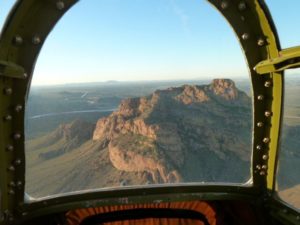
A passenger in the Maid is subjected to heat, noise, in-flight jostling and the all-permeating odor of sweat, avgas, oil and hydraulic fluid. But in years of doing this, I have yet to see anyone who did not thoroughly enjoy the experience. The smiles upon exit from the aircraft are broad and the exclamations enthusiastic.
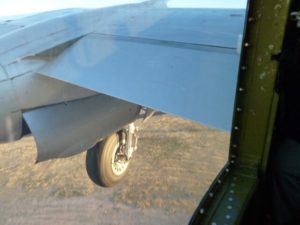
Landing Gear in Transit
An Oily Cleanup Project
But the end of the flight does not mean the end of the day’s work. The first task is to wipe the Maid clean of oil. As mentioned earlier, each of the Maid’s engines goes through about a gallon of oil for each hour of operation, but it is my firm belief that the engines leak oil at a much greater rate as the aircraft’s wings and fuselage are coated at the end of each flight.
The aircrew wipes the Maid down with clean rags to remove the worst of it, sometimes with the aid of the former passengers. (I’ve even seen passengers keep the oil-soaked rags as souvenirs.)
On non-fly days the Maid is subject to a more thorough going over with a cleaning agent. (Care must be taken when cleaning the Maid’s aluminum skin. One of the best cleansers we have found for removing oil is a product with the puerile name of Totally Awesome. It really is “totally awesome” for removing grease and oil, and I have begun using it instead of carburetor cleaner for my oil-encrusted Triumph Spitfire parts. For more information on the product, visit lastotallyasesome.com or call 714-562-8873.)
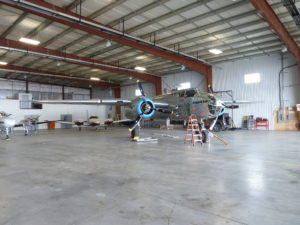
At the end of the day, the Maid is parked on the ramp and buttoned up. If rain is predicted and hanger space is not available (as it most often is not), the aircraft covers are fitted. It is much preferred that the Maid be hangared if there is the chance of inclement weather. Hail is particularly dreaded, as it can break plexiglass windows, dent the aircraft’s aluminum skin, and even penetrate the Maid’s fabric control surfaces.
Non-fly days on tour are also used to catch up with the aircraft’s minor upkeep and phase maintenance items, and there are numerous items to address with a 70+ year old aircraft. (Again, as with the oil leaks, the near-continuous maintenance reminds me of my dear LBCs.) There are also many non-flying tasks during tour, more than there are people to accomplish them, and so each person will normally fulfill two or more roles. During my latest tour, I sold souvenirs, performed ride coordinator duties, helped to navigate the AZCAF support truck and trailer over hundreds of miles of Canadian highways, introduced the Maid to the public while on static display, and performed numerous other small tasks, all in addition to the regular FLM duties. There is never a lack of anything to do.
Vintage Planes & Vintage Cars…
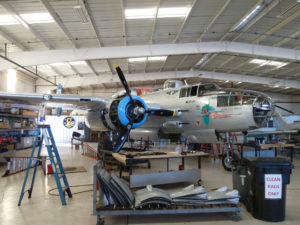
The Maid’s major maintenance and phase inspections are reserved for the winter months (October through May) when she is back in the AZCAF hanger. I am not an FAA-licensed Airframe & Powerplant (A&P) mechanic and so am limited in the aircraft work that I can do, but I can perform some of the simpler and more routine tasks under an A&P’s supervision. These normally consist of grunt work such as cleaning (a lot), removal and replacement of panels, and squeezing into tight spaces where others cannot. (I was once head and shoulders though a wing fuel cell access panel examining the cell for leaks.) Periodically, I assist in painting AZCAF aircraft components, e.g., wheels, cowlings, wing roots and fuselages, etc. Whatever there is to be done.
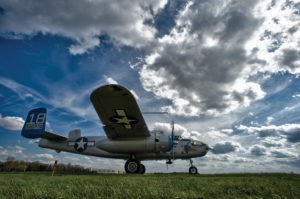
In many ways, working and flying on the Maid can be tedious, totally lacking in glamour and frequently tiring and dirty. (It brings back my own days in the Air Force.) But the to hear bark of her engines, to feel her rumble down the runway and surge into the air for an overhead pass, to see the excitement of the passengers as they debark, this more than compensates for any tedium or fatigue.
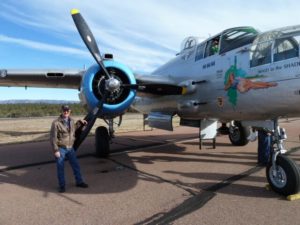
I’d say that if “airplane people” and “car people” have one thing in common, it is a love for cantankerous old machines and a dedication to keep them going for others to enjoy.
